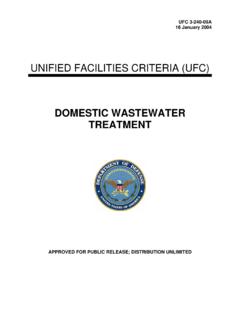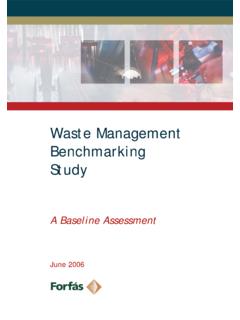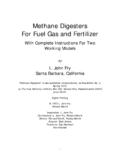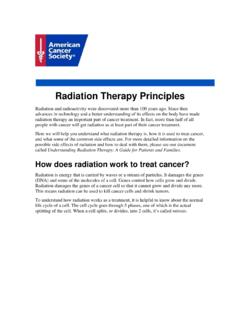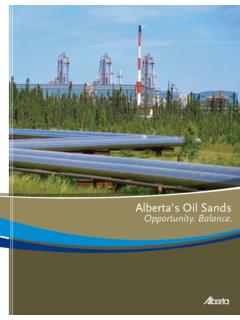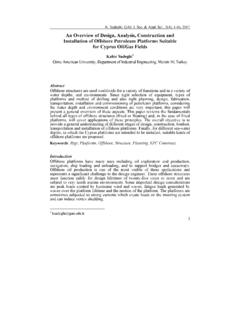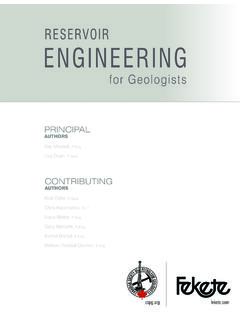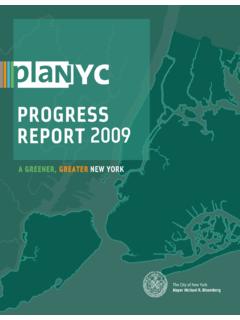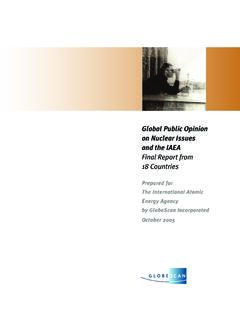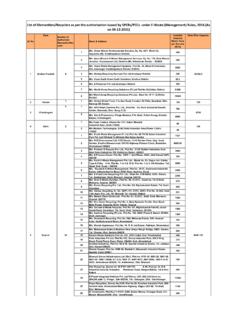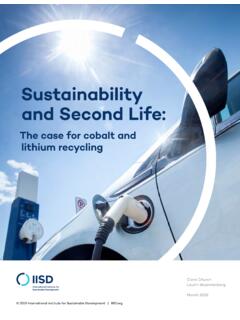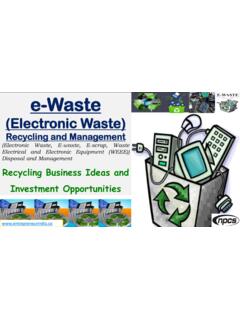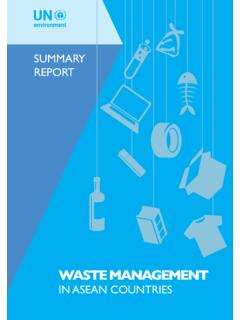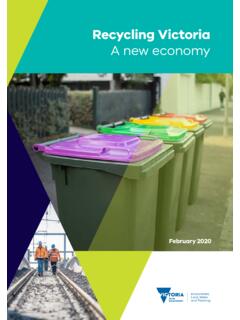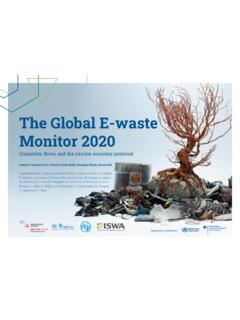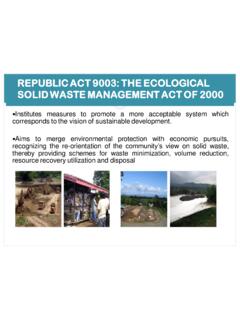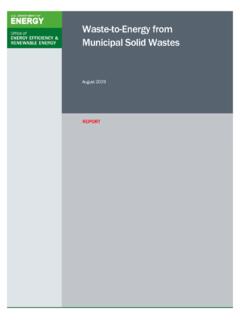Transcription of WASTE TECHNOLOGIES: WASTE TO ENERGY FACILITIES
1 WASTE technologies : WASTE TO ENERGY FACILITIES A Report for the Strategic WASTE Infrastructure Planning (SWIP) Working Group Complied by WSP Environmental Ltd for the Government of Western Australia, Department of Environment and Conservation May 2013 Project number: 00038022 Dated: May 2013 2 Revised: Quality Management Issue/revision Issue 1 Revision 1 Revision 2 Revision 3 Remarks Date May 2013 Prepared by Kevin Whiting, Steven Wood and Mick Fanning Signature Checked by Matthew Venn Signature Authorised by Kevin Whiting Signature Project number 00038022 Report number File reference 3 WASTE technologies : WASTE to ENERGY FACILITIES A Report for the Strategic WASTE Infrastructure Planning (SWIP) Working Group, commissioned by the Government of Western Australia, Department of Environment and Conservation.
2 May 2013 Client WASTE Management Branch Department of Environment and Conservation Level 4 The Atrium, 168 St George s Terrace, PERTH, WA 6000 Locked Bag 104 Bentley DC WA 6983 Consultants Kevin Whiting Head of ENERGY -from- WASTE & Biomass Tel: +44 207 7314 4647 Mick Fanning Associate Consultant Tel: +44 207 7314 5883 Steven Wood Principal Consultant Tel: +44 121 3524768 Registered Address WSP Environmental Limited 01152332 WSP House, 70 Chancery Lane, London, WC2A 1AF Project number: 00038022 Dated: May 2013 4 Revised: Table of Contents 1 Introduction .. 6 Objectives .. 6 Scope .. 6 Structure of this Report .. 6 2 Overview of WASTE to ENERGY technologies .. 7 Introduction .. 7 Direct Combustion (Incineration).
3 8 Gasification .. 10 Slagging 13 Plasma 14 Pyrolysis .. 14 3 Key Characteristics Review .. 17 Introduction .. 17 Key Parameters .. 17 4 Summary and Conclusions for the SWIP .. 45 Summary: Benefits and Disadvantages .. 45 Conclusions: WtE in WA .. 47 Glossary .. 49 5 List of Abbreviations APCr Air Pollution Control residues ATT Advanced Thermal Treatment BAT Best Available Techniques BREF Best Available Techniques reference document (EU) C&I Commercial & Industrial C&D Construction & Demolition CFB Circulating Fluidised Bed CO2 Carbon Dioxide CO2e Carbon Dioxide equivalent CO Carbon Monoxide CV Calorific Value EC European Commission ELV Emission Limit Values EPA Environmental Protection Authority EU European Union FP Fine Particles HPA Health Protection Agency (UK) IED Industrial Emissions Directive (EU)
4 GHG Greenhouse Gas IBA Incinerator Bottom Ash LHV Lower Heat Value MBI Mass Burn Incineration MBT Mechanical Biological Treatment MHT Mechanical Heat Treatment MSW Municipal Solid WASTE MW Megawatts NO2 Nitrogen Dioxide PM Particulate Matter RDF Refuse Derived Fuel rMSW Residual MSW SO2 Sulphur Dioxide SRF Solid Recovered Fuel TEQ Toxic Equivalent VOC Volatile Organic Carbon WFD WASTE Framework Directive (EU) WID WASTE Incineration Directive (EU) Project number: 00038022 Dated: May 2013 6 Revised: 1 Introduction Objectives The Western Australian WASTE Strategy (the Strategy) sets out WASTE recovery targets for municipal solid WASTE (MSW), commercial and industrial (C&I) and construction and demolition (C&D) WASTE streams and the measures that will assist the achievement of these targets.
5 Allied to the Strategy, the Department of Environment and Conservation (DEC) and the WASTE Authority established a Strategic WASTE and recycling Infrastructure Plan (SWIP) for the Perth Metropolitan and Peel regions, with a SWIP Working Group convened to support and guide its development. This review has been prepared to provide the working group with supporting information on thermal WASTE to ENERGY (WtE) technologies that should be considered during the development of the SWIP. This incorporates a description of the various thermal WtE technology types and differences covering key development and operating parameters at facility level based on information provided by established plants or available generic literature/data.
6 Where appropriate, process specific information is also provided in tabulated format. Scope The focus of this study is on thermal treatment technologies . Direct Combustion (incineration). Grate Fluidised Bed Gasification Grate Fluidised Bed Slagging Plasma Pyrolysis Structure of this Report Section 2 General overview of thermal treatment WtE Section 3 Review of key characteristics for variant technologies Section 4 Summary and conclusions for the SWIP 7 2 Overview of WASTE to ENERGY technologies Introduction WASTE to ENERGY (WtE) is a very broad term that covers any process that converts WASTE into ENERGY , or an ENERGY -carrying product, such as a gas or oil. Despite the existence of many different technologies , the aims of all WtE processes are essentially the same: Reduce the volume of WASTE and hence reduce the volume requiring disposal in landfill; Reduce the biodegradable fraction of WASTE to zero, and Produce a useful commodity (typically electricity and/or heat) from non-recyclable WASTE .
7 WtE can be split into two main categories: Thermal - includes combustion, gasification and pyrolysis, related processes all of which subject WASTE to high temperatures but with varying oxygen concentrations. Biological anaerobic digestion (AD). AD is can be used to recover ENERGY from wet, biodegradable WASTE streams (such as food WASTE and farm slurry). AD uses micro-organisms in carefully controlled conditions to convert biomass into biogas consisting primarily of methane and carbon dioxide, and a stabilised residue known as digestate. For the purpose of this study we only consider thermal technologies as AD is not suitable for the treatment of solid mixed municipal and commercial WASTE . Landfill gas collection will also be excluded from this report as this should be covered in the parallel document on landfill technologies .
8 The general market status of the three main thermal WtE technology groups are summarised below and in Figure 1. The processes and technologies are described in the following sections. Direct Combustion (Incineration) Combustion (incineration) of WASTE is very well established. Moving grate combustion is a mature technology with hundreds of examples worldwide. Fluidised bed plants are also well established, but require preparation of fuel and there are fewer examples. The vast majority of plants recover heat from the flue gases via a steam boiler. Very low emissions and high overall thermal efficiencies can be achieved in modern WASTE combustion plant. Gasification Gasification of WASTE is an emerging technology, but is mature in some regions, particularly Japan where there are many examples.
9 Gasification takes place in a restricted oxygen atmosphere, where WASTE is converted to a synthesis gas (syngas). Most plants then simply combust this gas (known as close-coupled gasification ); however it is possible to use syngas in a gas engine or turbine, resulting in higher efficiencies and other potential advantages ( advanced gasification ), but this is technically challenging and yet to be fully proven commercially. Gasification appears to be at the point of being able to compete with more established combustion processes, including at larger scales, so we expect to see a substantial increase in the number of WASTE gasification plants in the coming years. Plasma gasification is an emerging technology with few commercial plants but a number planned, including at least one large scale example.
10 Project number: 00038022 Dated: May 2013 8 Revised: Pyrolysis There are no known examples of commercial-scale mixed WASTE pyrolysis plants. Various technologies exist that include a pyrolysis stage that have reached commercial deployment ( Thermoselect), but no true pyrolysis processes where bio-oil is the primary product have been successfully deployed. We consider it unlikely that pyrolysis of mixed WASTE will be commercially viable in the near future. Figure 1: Thermal treatment options for solid WASTE Direct Combustion (Incineration) Combustion (incineration) of WASTE is achieved by heating WASTE in an excess of oxygen. Mass burn refers to a process that accepts raw or post recycling municipal solid WASTE (MSW) without any additional pre-treatment ( no shredding or refuse derived fuel (RDF) production).
